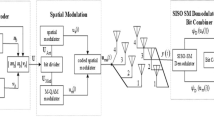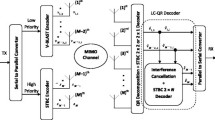Abstract
In this paper, we propose a new QR-based selection criterion with reduced complexity for the development of switching between spatial multiplexing (SM) and spatial diversity (SD) transmission. Then, we investigate an effect of the QR-decomposition processes by exploiting orthogonal structure of channel matrix. Additionally, to solve the problem of the error transmission mode in transmitter, we claim that the proposed QR-based detection at receiver can be used to form the successive interference cancellation (SIC) detection and orthogonal space-time block code (O-STBC) decoding for the SM transmission and the SD transmission, respectively. Simulation results show that the proposed scheme is capable of achieving optimum performance, but at a low-complexity level.
Similar content being viewed by others
References
Telatar I. E. (1999) Capacity of multi-antenna Gaussian channels. European Transactions on Telecommunications 10(6): 585–595
Vucetic B., Yuan J. (2003) Space-time coding. Wiley, England
Narasimhan R. (2006) Finite-SNR diversity-multiplexing tradeoff for correlated Rayleigh and Riciean MIMO channels. IEEE Transactions on Information Theory 52(9): 3965–3979
Foschini G. J., Golden G. D., Valenzuela R. A., Wolnianski P. W. (1999) Simplified processing for high spectral efficiency wireless communication employing multi-element arrays. IEEE Select Journal Areas in Communications 17(11): 1841–1852
Foscini G. J., Chizhik D., Gans M. J., Papadias C., Valenzuela R. A. (2003) Analysis and performance of some basic spac-time architectures. IEEE Select Journal Areas in Communications 21(3): 303–320
Alamouti S. M. (1998) A simple transmit diversity technique for wireless communications. IEEE Select Journal Areas in Communications 16(8): 1451–1458
Tarokh V., Jafarkhani H., Calderbank A. R. (1999) Space-time block codes from orthogonal designs. IEEE Transactions on Information Theory 45(5): 1456–1467
Zheng L., Tse D. N. C. (2003) Diversity and multiplexing: A fundamental tradeoff in multiple-antenna channels. IEEE Transactions on Information Theory 49(5): 1073–1096
Heath R. W., Paulraj A. J. (2005) Switching between diversity and multiplexing in MIMO systems. IEEE Transactions on Communications 53(6): 962–968
Demmel J. W. (1988) The probability that a numerical analysis problem is difficult. Mathematics of Computation 50: 449–480
Heath, R. W. Jr., & Love D. J. (2003). Multi-mode antenna selection for spatial multiplexing systems with linear receivers. In Proceeding of the allerton conference on communication, control, and computer, Monticello, IL, Oct.
Zhou S., Li B. (2006) BER criterion and codebook construction for finite-rate precoded spatial multiplexing with linear receivers. IEEE Transactions on Signal Processing 54(6): 1653–1665
Love D. J., Heath R. W. (2005) Limited feedback unitary precoding for orthogonal space-time block codes. IEEE Transactions on Signal Processing 53(1): 64–73
Love D. J., Heath R. W. (2005) Limited feedback unitary precoding for spatial multiplexing system. IEEE Transactions on Information Theory 51(8): 2967–2976
Wübben, D., Rinas, J., Bohnke, R., Kuhn, V., & Kammeyer, K. D. (2002). Efficient algorithm for detecting layered space-time codes. In Proceedings of the 4th international ITG conference on source and channel coding (pp. 399–405). Berlin, Germany.
Jalden J., Ottersten B. (2005) On the complexity of sphere decoding in digital communications. IEEE Transactions on Signal Processing 53(4): 1474–1484
Pan, C. H., Lee, T.,S., & Li, Y. (2007) An efficient near-ML algorithm with SQRD for wireless MIMO communications in metro transportation systems. In Proceedings of IEEE ITSC (pp. 603–606). Seattle, WA, USA.
Pan, C. H., Lee, T. S., & Li, Y. (2007). A hybrid multiuser detection technique based on interference cancellation knowledge in MIMO communications. In Proceedings of the 19th INCF, Tokyo, Japan, Sept.
Pan, H. C., Lee, T. S., & Li, Y. (2007). A near-optimal low-complexity transceiver based on interference cancellation knowledge for MIMO-OFDM systems. In Proceedings of 4th IEEE VTS conference on APWCS (pp. 121–123). Taiwan.
Horn, R. A., & Johnson, C. R. (1991; 1994). Topics in matrix analysis. Cambridge University Press.
Yoo T., Goldsmith A. (2006) Capacity and power allocation for fading MIMO channel with channel estimation error. IEEE Transactions on Information Theory 52(5): 2203–2214
Godavarti, M., & Hero, A. O. (2002). Diversity and degrees of freedom in wireless communication. In Proceedings of ICASSP (Vol. 3, pp. 2861–2854).
Conway J. B. (1978) Functions of one complex variable (2nd ed.). Springer, New York
Farrokhi F. R., Soschini G. J., Lozano A., Valenzuela R. A. (2001) Link-optimal space-time processing with multiple transmit and receiver antennas. IEEE Communications Letters 5(3): 85–87
Wubben, D., Kuhn, V., & Kammeyer, K. D. (2004). The robustness of lattice-reduction aided detectors in correlated MIMO systems. In IEEE Transactions on vehicular technology conference (Vol. 5, pp. 3639–3643). Los Angles, USA.
Author information
Authors and Affiliations
Corresponding author
Additional information
Part of this work was presented at the 2007 IEEE Conference on Intelligent Transportation Systems (ITS), Seattle, WA, USA, Sept. 2007. This work is sponsored jointly by the National Science Council of in Taiwan.
Rights and permissions
About this article
Cite this article
Pan, CH. A Robustness and Low-Complexity Selection Criterion for Switching between Multiplexing and Diversity in MIMO Transmission. Wireless Pers Commun 60, 171–190 (2011). https://doi.org/10.1007/s11277-010-9937-3
Published:
Issue Date:
DOI: https://doi.org/10.1007/s11277-010-9937-3




